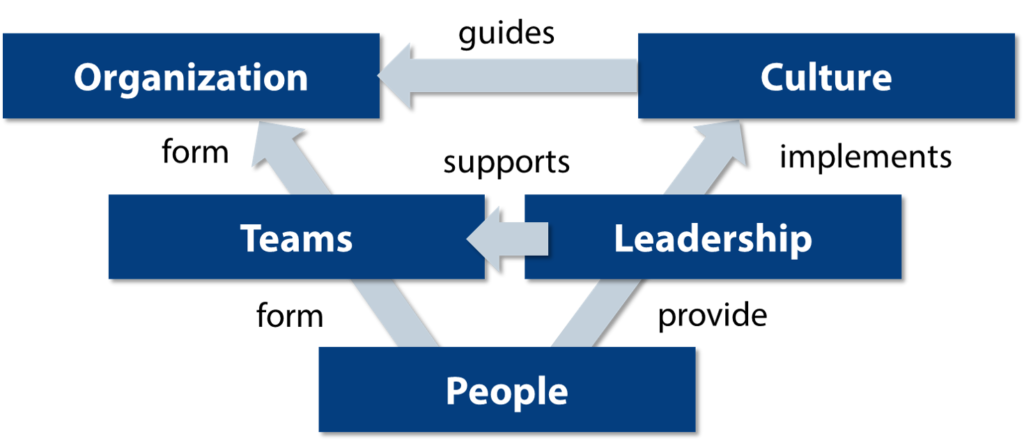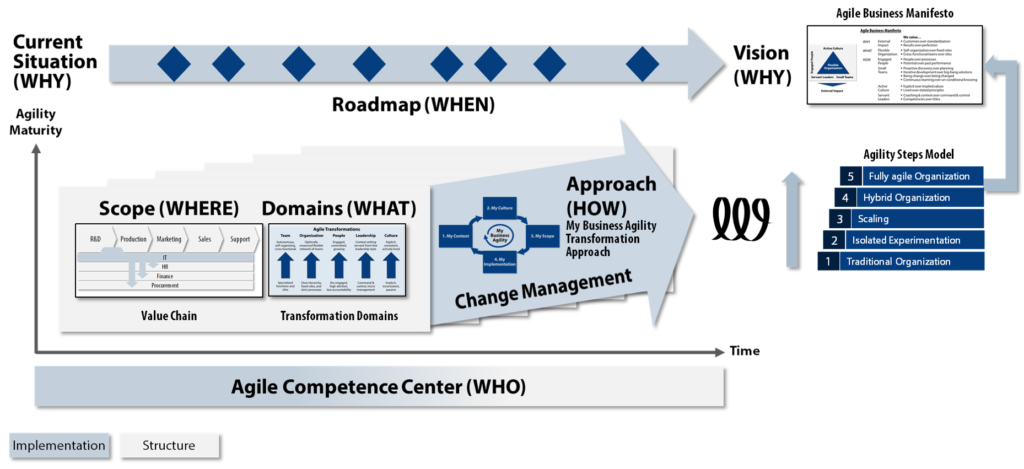VUCA and Agile
In VUCA times, businesses need to be more agile to succeed. Agile seems to be “eating the world“. After two decades of success on a team and project level the expectations are high. More than 90% of senior executives give high priority to becoming agile, while less than 10% see their firm as currently highly agile.
The State of Business Agility
Business agility is different to team agility and less mature. Business agility is complex and highly individual: Recognizing individual situations early, flexibly catering for the individual needs of a diverse global customer base, and quickly developing new capabilities to create individual USP. The key to business agility is not following a single book but understanding the value of agile for the business and deciding how to individually achieve it. My Business Agility provides a framework for achieving individual business agility.
Many concepts and methodologies are labelled ‘agile’. Some have been around longer than the agile manifesto which started the agile movement in 2001. Scrum, for example, dates back to 1986. Successful business use them already. They include, for example, customer orientation, delegation and high performance teams. My Business Agility provides a flexible framework to plan and execute an agile transformation.
Many of those new or old agile concepts are not easy to implement, especially on a business level. Yet, the need for it is greater than ever. In the age of agile, businesses need to start using agile while continuing their individual approaches to higher business performance.
My Business Agility provides a framework to integrate agile concepts and methodologies to drive business performance and success.
Going Hybrid
Young businesses like Grab, Netflix, and Spotify are ‘born agile’ and will continue to evolve and succeed as fully agile organizations.
Established and large organizations have to start somewhere. Adopt agile where it makes most sense and evolve as hybrids balancing the best of both worlds from agile and proven ways of working by bringing together the new and the old, flexibility and stability, speed and quality, innovation and operations. For example, airlines may never want to become 100% agile. Their proven ways of working ensure safety and operational excellence which are the foundation for their business success. You don’t want to touch this. But they should consider agile where it makes sense. They should be hybrid and balance the best of both worlds.
My Business Agility provides a framework for defining where to start and balancing the best from agile and proven ways of working for optimal business performance and success.
Agile transformation Domains
In pursuit of the new balance, an agile transformation requires often significant change affecting People, Teams, Leadership, Culture and the Organization – the domains of an agile organization:

Doing Business Agility
The My Business Agility approach for an agile transformation has the following elements:

- The Vision outlines the direction and aspirations of the business. The Agile Business Manifesto guides the development of an individual agile business vision and the assessment of the Current Situation. Together, they answer the question: “Why do we need business agility?” and create the case for change.
- The Scope fine-tunes the identification of the areas, departments, functions, and/or locations that will benefit most from the adoption of agile. Using a combination of a value chain and value stream mapping it defines the “Where” of an agile transformation.
- The Agile Transformation Domains define “What” to change. They are the five building blocks of an agile business: people, teams, leadership, culture and organization as illustrated above.
- The Agile Transformation Approach implements the vision, scope and domains. It is based on an iterative approach that gradually builds agile capabilities while continuously learning and adapting supported by solid Change Management.
- The Roadmap documents the milestones to achieve higher business agility.
- The Agility Steps Model informs the roadmap in achievement of a balanced, stable agile vision as a hybrid or fully agile organization.
- The Agile Competence Center leads the transformation and eventually become permanent to ensure continuous learning and adaptation.
Tackling the hard parts
The hardest part of an agile transformation is the culture and leadership transformation. The shift to agile ways of working will seriously challenge some. You need to give them time and support to adapt. This requires professional change management that leaves no-one behind.
My Business Agility adopts a comprehensive 360° change management approach that effectively addresses the people side of an agile transformation.
Your Agile Business V1
The endpoint of an agile transformation is V1 of your agile business. A business that is by itself capable of continuously recognizing the need for change, learning and adapting.
In a traditional organization, change is a big, top-down, ad-hoc, expensive, heavy-lifting exercise that inflicts change on others and often burns out people.
In a V1 agile organization change becomes an incremental, bottom-up, continuous activity that is owned and driven by your people for your people.
My Business Agility creates change ready organizations where everybody evolves from being changed to being change.
Continuing Your Agile Journey
Once an organization has achieved this V1 state of an agile organization the need for large transformations is gone. The organization is now on a never ending agile journey where it adapts continuously to its environment ensuring sustainable business performance and success even in the most VUCA times.
Getting started
Agile is done agile. My Business Agility does not require the creation of a complex and costly program. Instead, it aims at identifying the best place to start, and start implementing immediately. Stop talking, start doing. VUCA does not wait. 91% of organizations have started already.
If you want to find out more, please contact us or subscribe below so we can keep you updated.
